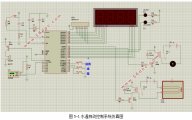水温自动控制系统的设计
来源:56doc.com 资料编号:5D26667 资料等级:★★★★★ %E8%B5%84%E6%96%99%E7%BC%96%E5%8F%B7%EF%BC%9A5D26667
资料以网页介绍的为准,下载后不会有水印.资料仅供学习参考之用. 密 保 惠 帮助
资料介绍
水温自动控制系统的设计(论文13000字)
摘要:本论文设计一款基于单片机的水温自动控制系统,通过温度传感器实时检测温度,利用继电器对温度进行恒温控制。本水温自动控制系统以STC89C51单片机为核心,实现DS18B20对环境温度的检测,利用数码管显示模块,实时显示检测的温度值,进而实现继电器对温度的升降控制。论文首先对水温自动控制系统的背景与研究意义进行介绍;然后对水温自动控制系统总体方案与硬件电路进行设计;根据单片机编程的特点,对整个水温自动控制系统进行软件算法设计;最后通过仿真,验证本文设计结果的有效性。
关键词:水温;自动控制;单片机
Design of the Water Temperature Automatic Control System
Abstract: Based on single chip microcomputer, the paper investigates a class of the water temperature automatic control systems. By the temperature sensor to detect the temperature in real time, the temperature is controlled by the relay. Based on microcontroller STC89C51, the water temperature automatic control system achieves DS18B20 detection to detect ambient temperature, uses digital display module to display the temperature value in real time, implement the rise and fall of temperature control by the relay. Firstly, the background and research significance of the automatic control system of water temperature are introduced in the paper. Then, the overall scheme and hardware circuit design of water temperature automatic control system are carried on. According to the characteristics of single chip microcomputer programming, the software algorithms of the whole water temperature automatic control system are proposed. Finally, simulation examples are given to illustrate the effectiveness of design results.
Key words: Temperature; Automatic control; Single chip microcomputer


目 录
1 前言 1
1.1 课题的背景 1
1.2 研究现状 1
1.3 论文研究主要内容和结构 2
2 水温自动控制系统的总体设计 3
2.1总体方案设计 3
2.2 温度检测仪介绍 3
2.3 控制方案选择介绍 5
2.4 显示方案选择介绍 8
3 水温自动控制系统的硬件设计 11
3.1 水温自动控制系统的设计总体电路 11
3.2 单片机主控电路 11
3.3 温度检测电路 13
3.4 数码管显示电路 13
3.5 按键电路设计 14
3.6 蜂鸣器报警电路 15
3.7 继电器控制电路 15
4 水温自动控制系统的软件设计 17
4.1 主程序设计 17
4.2 子程序设计 20
5 仿真设计与实验调试 23
5.1 仿真设计 23
5.2 实验与结果 24
6 结论 28
参考文献 28
致谢 30
|





